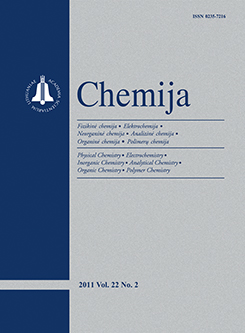Chemija / Chemistry
WHAT?
 ISSN 0235-7216 ISSN 2424-4538 (online) |
2011 m. Nr. 2 Chalcopentathionic compounds as pecursors for the formation of semiconductive and conductive copper chalcogenide layers on polyamide surface
Semiconductive and electrically conductive layers of copper chalcogenides – copper sulfides, CuxS, mixed copper sulfides – copper selenides, CuxS–CuySe, and mixed copper sulfides – copper tellurides, CuxS–CuyTe, – on the polyamide 6 (PA) surface were formed using the sorption-diffusion method and water solutions of potassium pentathionate, K2S5O6, potassium selenopentathionate, K2SeS4O6, and potassium telluropentathionate, K2TeS4O6, as the precursors of polymer chalcogenization. Chalcopentathionate anions containing chains of divalent chalcogen atoms of low oxidation state, –O3S–S–S–S–SO3 –, –O3S–S–Se–S–SO3– and –O3S–S–Te–S–SO3 –, are sorbed-diffused into PA films if they are treated with chalcopentathionic compound solutions. The concentrations of sorbed chalcogens increase with an increase of the temperature and concentration of the precursor solution and the duration of PA treatment. CuxS, CuxS–CuySe or CuxS–CuyTe layers are formed on the surface of PA film when a chalcogenized polymer is treated with a water solution of copper(II / I) salt: the anions of chalcopentathionates react with copper ions. The concentration of copper increases with increasing the concentration and temperature of precursor solution and the duration of PA initial chalcogenization. XPS and XRD results confirmed the formation of copper chalcogenide layers on PA surface. The phase composition of CuxS, CuxS–CuySe and CuxS–CuyTe layers depends on the conditions of PA chalcogenization, i. e. the concentration and temperature of chalcopentathionate solution and on the duration of initial treatment in the precursor solution. CuxS Layers formed using K2S5O6 solutions are composed of the low-conductive tetragonal chalcocite, Cu1.96S, monoclinic djurleite, Cu1,9375S, electrically conductive rhomhedral digenite, Cu9S5, orthorhombic anilite, Cu7S4, and cubic CuS2; layers of CuxS–CuySe formed using K2SeS4O6 solutions – of low conductive chalcocite, Cu2S, electrically conductive digenite, Cu1.8S, djurleite, Cu1.9375S, anilite, Cu1.75S, and of copper selenides – bellidoite, Cu2Se, umangite, Cu3Se2, klockmannite, CuSe, krutaite, CuSe2 and Cu2Sex; layers of CuxS–CuyTe formed using K2TeS4O6 solutions – of chalcocite, Cu2S, djurleite, Cu1.9375S, anilite, Cu1.75S, digenite, Cu1.8S, copper sulfide CuS2, copper tellurides Cu2.72Te2, Cu4Te3, Cu1.85Te, vulcanite, CuTe, Cu1.80Te. The phase composition determines the electrical characteristics of the obtained layers: the sheet resistance of CuxS layers varies from 0.104 to 1.52 · 103 KΩ / □, of CuxS–CuySe layers from 12.2 Ω / □ to 4.8 MΩ / □, of CuxS–CuyTe layers from ~1.0 kΩ / □ to 4 · 103 kΩ / □. The established regularities enable formation of CuxS, CuxS–CuySe and CuxS–CuyTe layers of a desirable composition and conductivity
Keywords: review, chalcopentathionates, polyamide, copper chalcogenide layer |
Issues:
2017 - Vol.28 No. 1, No. 2, No. 3, No. 4 2016 - Vol.27 No. 1, No. 2, No. 3, No. 4 2015 - Vol.26 No. 1, No. 2, No. 3, No. 4 2014 - Vol.25 No. 1, No. 2, No. 3, No. 4 2013 - Vol.24 No. 1, No. 2, No. 3, No. 4 2012 - Vol.23 No. 1, No. 2, No. 3, No. 4 2011 - Vol.22 No. 1, No. 2, No. 3, No. 4 2010 - Vol.21 No. 1, No. 2-4 2009 - Vol.20 No. 1, No. 2, No. 3, No. 4 2008 - Vol.19 No. 1, No. 2, No. 3-4 2007 - Vol.18 No. 1, No. 2, No. 3, No. 4 2006 - Vol.17 No. 1, No. 2-3, No. 4 2005 - Vol.16 No. 1, No. 2, No. 3-4 2004 - Vol.15 No. 1, No. 2, No. 3, No. 4 2003 - Vol.14 No. 1, No. 2, No. 3, No. 4 2002 - Vol.13 No. 1, No. 2, No. 3, No. 4 2001 - Vol.12 No. 1, No. 2, No. 3, No. 4 |